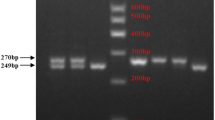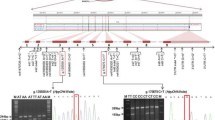Abstract
Visfatin is a protein that is preferentially produced in visceral adipose tissue. Both its tissue expression and secreted plasma levels increase in parallel with obesity. Therefore, the present study is focused on detecting insertion in bovine visfatin gene and analyzing its effect on growth traits in four Chinese cattle breeds (Nangyang, Qinchuan, Jiaxian, and Chinese Holstein) using PCR-SSCP, DNA sequencing and agarose electrophoresis methods. For the first time, a 35-bp insertion was described in the gene and two alleles were revealed: W and I. The x 2-test analysis demonstrated that all breeds were in agreement with Hardy-Weinberg equilibrium (P > 0.05). The associations of the novel 35 bp-insertion of visfatin gene with growth traits of Nanyang cattle at 6, 12, 18, and 24 months old were analyzed: 6 month-old cows with genotype WW had greater birth weight than cows with genotype II and WI (P < 0.01 or P < 0.05). These results suggest that the presence of 35 bpinsertion in visfatin gene may influence the birth weight and bodyweight in 6 month-old cows.
Similar content being viewed by others
References
Kershaw E.E., Jeffrey S.F. 2004. Adipose tissue as an endocrine organ. J. Clin. Endocrinol. Metab. 89, 2548–2556.
Fukuhara A. 2005. Visfatin: A protein secreted by visceral fat that mimics the effects of insulin. Science. 307, 426–430.
Jaswinder K.S., Antonio V.P. 2005. Visfatin: The missing link between intra-abdominal obesity and diabetes? Trends Mol. Med. 11, 344–347.
Ognjanovic S., Bao S., Yamamoto S.Y., Garibay-Tupas J., Samal B., Bryant-Greenwood G.D. 2001. Genomic organization of the gene coding for human pre-B-cell colony enhancing factor and expression in human fetal membranes. J. Mol. Endocrinol. 26, 107–117.
Osusky M., Stuchl S., Zock M., Dubaov M., Janitorov V., Turna J. 1994. Vectors with the fd replicon for in vivo cloning and analysis of genes. Gene. 151, 103–108.
Samal B., Sun Y., Stearns G., Xie C., Suggs S., McNiece I. 1994. Cloning and characterization of the cDNA encoding a novel human pre-B-cell colonyenhancing factor. Mol. Cell. Biol. 14, 1431–1437.
Mistry T., Digby J.E., Raghu R., Joe J., Desai K.M., Randeva H.S. 2008. A novel role for the adipokine visfatin (pre-B cell colony-enhancing factor1 (PBEF)/nicotinamide phosphoribosyl transferase (nmprtase)) in prostate carcinogenesis. Eur. Urol. Suppl. 7, 312–313.
Nora K., Ingrid K. 2005. Visfatin: Gene expression in isolated adipocytes and sequence analysis in obese WOKW rats compared with lean control rats. Biochem. Biophys. Res. Commun. 332, 1070–1072.
Yvonne B., Teupser D., Enigk B., Berndt J., Kloting N., Michael R.S., Thiery J., Bluher M., Stumvoll M., Kovacs P. 2006. Genetic variation in the visfatin gene (PBEF1) and its relation to glucose metabolism and fatdepot-specific messenger ribonucleic acid expression in humans. J. Clin. Endocrinol. Metab. 91, 2725–2731.
Berndt J., Kloting N., Kralisch S., Kovacs P., Fasshauer M., Schon M.R., Stumvoll M., Bluher M. 2005. Plasma visfatin concentrations and fat depot-specific expression in humans. Diabetes. 54, 2911–2916.
Palin M.F., Labrecque B., Beaudry D., Mayhue M., Bordignon V., Murphy B.D. 2008. Visfatin expression is not associated with adipose tissue abundance in the porcine model. Domest. Anim. Endocrinol. 35, 58–73.
Lan X.Y., Pan C.Y., Chen H., Zhang C.L., Li J.Y., Zhao M., Lei C.Z., Zhang A.L., Zhang L. 2007. An AluI PCR-RFLP detecting a silent allele at the goat POU1F1 locus and its association with production traits. Small Ruminant Res. 73, 8–12.
Nei M., Li W.H. 1979. Mathematic model for studying genetic variation in terms of restriction endonucleaes. Proc. Natl. Acad. Sci. USA. 76, 5269–5273.
Botstein D., White R.L., Skolnick M., Davis R.W. 1980. Construction of a genetic linkage map in man using restriction fragment length polymorphisms. Am. J. Hum. Genet. 32, 314–331.
Zhao Q., Davis M., Hines H.C. 2004. Associations of polymorphisms in the Pit-1 gene with growth and carcass traits in Angus beef cattle. J. Anim. Sci. 82, 2229–2233.
Author information
Authors and Affiliations
Corresponding author
Additional information
The article is published in the original.
These authors equally contributed to this paper.
Rights and permissions
About this article
Cite this article
Wang, M., Yu, H., Chen, H. et al. Novel 35-bp insertion in Visfatin Gene in Chinese cattle. Mol Biol 43, 557–561 (2009). https://doi.org/10.1134/S0026893309040049
Received:
Accepted:
Published:
Issue Date:
DOI: https://doi.org/10.1134/S0026893309040049




